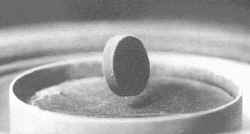New Info from Slow Muons

The magnetic properties of superconductors are at least as fascinating as their extremely high electrical conductivity. As researchers try to understand the new high temperature superconductors (HTSCs) at a fundamental level, they need to scrutinize magnetic fields inside these materials. A new technique using cold muons, described in the 22 May PRL, can probe these fields within nanometers of a material’s surface–by far the most detailed look ever. The authors verified that a magnetic field penetrates just inside the surface of a HTSC in exactly the way established theories predict, but other questions remain open regarding the internal field configurations within HTSCs. Experts say the technique promises applications to many other areas of condensed matter physics as well.
Internal magnetic fields are hard to measure, and muons provide one of the few probes up to the task. A muon is a heavier, shorter-lived sibling of the electron, and by virtue of its spin, the muon is sensitive to magnetic fields. In the technique called muon spin rotation (µSR) energetic muons plow into a sample and get stuck inside, like BBs shot into a loaf of bread. When muons expire–after 2 microseconds on average–they beget electrons, and by carefully observing these electrons, researchers obtain precise pictures of the magnetic field at the site where the muons took their last breaths.
The typical limitation to the muon spin rotation technique arises from the muons’ high speed. “Conventional muons, with energies of about 4 MeV, will pass straight through many samples of interest,” says Ted Forgan, of the University of Birmingham in England, a co-author of the new paper. At this energy, traveling at one-fifth the speed of light, muons embed themselves relatively deep inside a target. Elvezio Morenzoni and his colleagues at the Paul Scherrer Institute in Switzerland refined the latest µSR technique, in which they slow the muons to just 15 eV in energy by sending them through a dense gas. By varying a voltage that accelerates the muons, the team can control the precise depth to which the particles penetrate a sample.
A superconductor provided the ideal first task for the technique. A cold superconductor normally expels magnetic fields from its interior, but the field infiltrates the edges of the superconductor to a depth of hundreds of nanometers. Since the mid-1930s, physicists have assumed that the internal magnetic field strength decreases exponentially with increasing depth, but no one had devised a way to directly measure the field strength so close to the surface. In the new experiments, Forgan, Morenzoni, and their colleagues used muons at six different energies between 3 and 30 keV to probe a HTSC to a depth of up to 152 nm. The results show a precisely exponential decrease of the penetrating magnetic field, confirming the decades-old assumption, and showing that HTSCs follow the same behavior as traditional superconductors.
Jeff Sonier, of Los Alamos National Laboratory in New Mexico, sees significant implications for the added capabilities of µSR. The research community now has “a sensitive magnetic probe which can be used to study both the surface and bulk of the same sample,” he says. That will allow more precise tests of theories of superconductivity and other magnetic phenomena.
–Brandon Brown
Brandon Brown is an Assistant Professor of Physics at the University of San Francisco and a freelance science writer.


